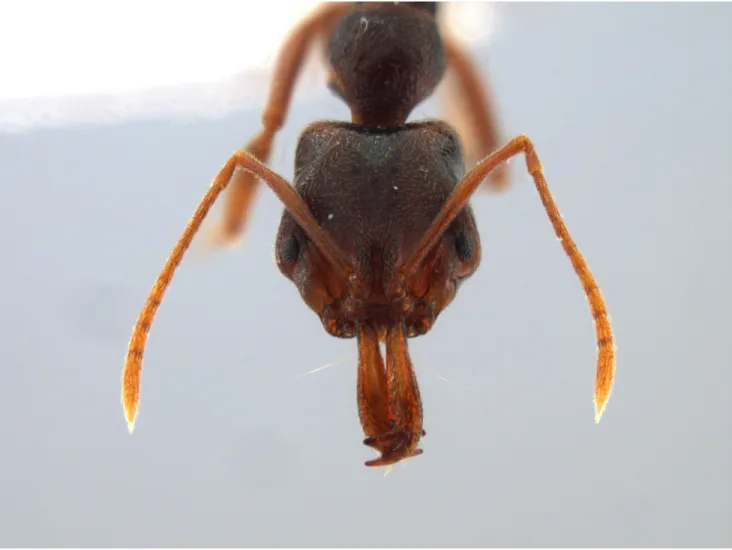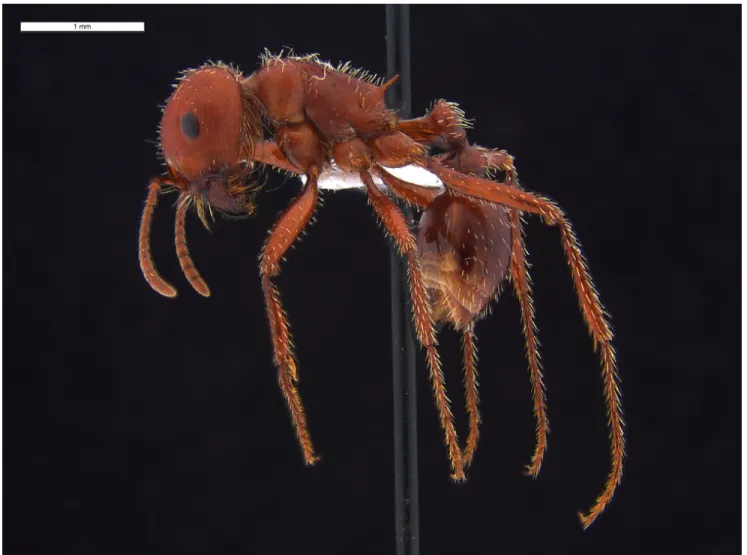Article e01666 Photo Gallery April 2020 1
MEXICO’S ANTS: WHO ARE THEY AND WHERE DO THEY
LIVE?
Wesley Dáttilo , Miguel Vásquez-Bolaños, Diana A. Ahuatzin, Reuber Antoniazzi , Edgar Chávez-González , Erick Corro , Pedro Luna , Roger Guevara, Fabricio Villalobos, Ricardo Madrigal-Chavero, Jéssica C. de Faria Falcão , Adrián Bonilla-Ramírez, Agustín Rafael García Romero, Aldo de
la Mora, Alfredo Ramírez-Hernández, Ana Leticia Escalante-Jiménez, Ana P. Martínez-Falcón, Andrés I. Villarreal, Ashley García Colón Sandoval, Bolívar Aponte, Brenda Juárez-Juárez, Citlalli Castillo-Guevara, Claudia E. Moreno, Cristopher Albor, Dora Luz Martínez-Tlapa, Elisabeth Huber-Sannwald, Federico Escobar, Fernando J. Montiel-Reyes, Fernando Varela-Hernández, Gabriela Castaño-Meneses ,
Gabriela Pérez-Lachaud, Gibrán Renoy Pérez-Toledo, Irene Alcalá-Martínez, Iris Saraeny Rivera-Salinas, Isaías Chairez-Hernández, Ivette A. Chamorro-Florescano, Jaime Hernández-Flores, Javier Martínez Toledo, Jean-Paul Lachaud, Jesús Lumar Reyes-Muñoz, Jorge E. Valenzuela-González, Jorge Víctor
Horta-Vega, José Domingo Cruz-Labana, José Javier Reynoso-Campos, José L. Navarrete-Heredia, Juan Antonio Rodríguez-Garza, Juan Francisco Pérez-Domínguez, Julieta Benítez-Malvido, Katherine K.
Ennis, Laura Sáenz, Luis A. Díaz-Montiel, Luis Antonio Tarango-Arámbula, Luis N. Quiroz-Robedo, Madai Rosas-Mejía, Margarita Villalvazo-Palacios, María Gómez-Lazaga, Mariana Cuautle, Mario J. Aguilar-Méndez, Martha L. Baena, Martha Madora-Astudillo, Maya Rocha-Ortega, Michel Pale, Miguel A.
García-Martínez, Miguel Angel Soto-Cárdenas, Miguel Mauricio Correa-Ramírez, Milan Janda, Patricia Rojas, René Torres-Ricario, Robert W. Jones, Rosamond Coates, Sandra Luz Gómez-Acevedo, Saúl Ugalde-Lezama, Stacy M. Philpott , Tatiana Joaqui, Tatianne Marques, Veronica Zamora-Gutierrez,
Viviana Martínez Mandujano, Zachary Hajian-Forooshani , and Ian MacGregor-Fors
© 2020 The Authors. The Bulletin of the Ecological Society of America, published by Wiley Periodicals, Inc., on behalf of the Ecological Society of America. This is an open access article under the terms of the Creative Commons Attribution License, which permits use, distribution and reproduction in any medium, provided the original work is properly cited.
Dáttilo, W., M. Vásquez-Bolaños, D. A. Ahuatzin, R. Antoniazzi, E. Chávez-González, E. Corro, P. Luna, R. Guevara, F. Villalobos, R. Madrigal-Chavero, J. C. de Faria Falcão, A. Bonilla-Ramírez, A. R. G. Romero, A. de la Mora, A. Ramírez-Hernández, A. L. Escalante-Jiménez, A. P. Martínez-Falcón, A. I. Villarreal, A. G. C. Sandoval, B. Aponte, B. Juárez-Juárez, C. Castillo-Guevara, C. E. Moreno, C. Albor, D. L. Martínez-Tlapa, E. Huber-Sannwald, F. Escobar, F. J. Montiel-Reyes, F. Varela-Hernández, G. Castaño-Meneses, G. Pérez-Lachaud, G. R. Pérez-Toledo, I. Alcalá-Martínez, I. S. Rivera-Salinas, I. Chairez-Hernández, I. A. Chamorro-Florescano, J. Hernández-Flores, J. M. Toledo, J.-P. Lachaud, J. L. Reyes-Muñoz, J. E. Valenzuela-González, J. V. Horta-Vega, J. D. Cruz-Labana, J. J. Reynoso-Campos, J. L. Navarrete-Heredia, J. A. Rodríguez-Garza, J. F. Pérez-Domínguez, J. Benítez-Malvido, K. K. Ennis, L. Sáenz, L. A. Díaz-Montiel, L. A. Tarango-Arámbula, L. N. Quiroz-Robedo, M. Rosas-Mejía, M. Villalvazo-Palacios, M. Gómez-Lazaga, M. Cuautle, M. J. Aguilar-Méndez, M. L. Baena, M. Madora-Astudillo, M. Rocha-Ortega, M. Pale, M. A. García-Martínez, M. A. Soto-Cárdenas, M. M. Correa-Ramírez, M. Janda, P. Rojas, R. Torres-Ricario, R. W. Jones, R. Coates, S. L. Gómez-Acevedo, S. Ugalde-Lezama, S. M. Philpott, T. Joaqui, T. Marques, V. Zamora-Gutierrez, V. M. Mandujano, Z. Hajian-Forooshani, and I. MacGregor-Fors. 2020. Mexico’s Ants: Who are They and Where do They Live? Bull Ecol Soc Am 101(2):e01666. https ://doi.org/10.1002/bes2.1666
Study Description
A team of 79 scientists from more than 50 institutions partnered to gather all available information regarding Mexican ants since 1894, the year in which the first geographical record of an ant is known for the country. In this new study, including more than 21,000 records, we showed that there are ~900 species of ants in Mexico, which are distributed unevenly across the country. Mexico is one of the relatively few countries along the interface of the tropical and temperate zones, and is a megadiverse country.
2 Bulletin of the Ecological Society of America, 101(2) Article e01666 Photo Gallery
Figure 1. Trap- jaw ant Anochetus mayri (Formicidae: Ponerinae), a species with small nests native to Mexico and distributed in the Neotropical and Transition zone of the country, occurring from sea level to an elevation of ~1000 m. Photo credit: Diana Ahuatzin.
Article e01666 Photo Gallery April 2020 3
Figure 2. Turtle ant Cephalotes scutulatus (Formicidae: Myrmicinae), a tree- dwelling myrmicine ant species native to Mexico and distributed in the Neotropical and Transition zone of the country occur-ring from sea level to an elevation of ~1200 m. Photo credit: Diana Ahuatzin.
4 Bulletin of the Ecological Society of America, 101(2) Article e01666 Photo Gallery
Figure 3. Red harvester ant Pogonomyrmex barbatus (Formicidae: Myrmicinae), an ant species native to Mexico and dominant in the arid and semiarid highlands of the country, mainly due to their large colonies and wider trophic niche, which includes fruits, seeds, twigs, leaves, flowers, and invertebrates. Photo credit: Pedro Luna.
These photographs illustrate the article “Mexico ants: incidence and abundance along the Nearctic- Neotropical interface” by Wesley Dáttilo et al. published in Ecology. https ://doi. org/10.1002/ecy.2944

